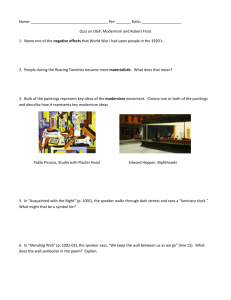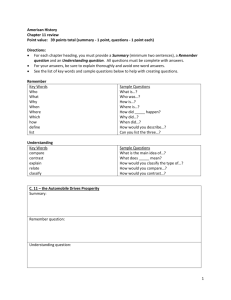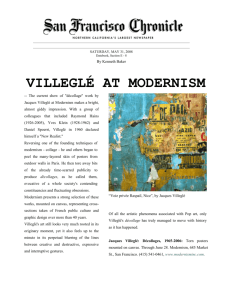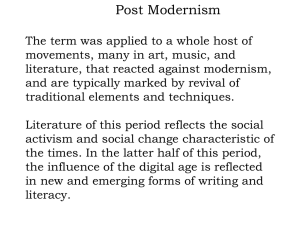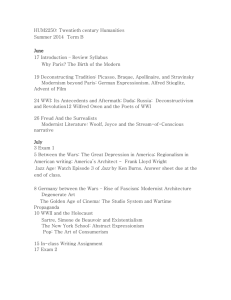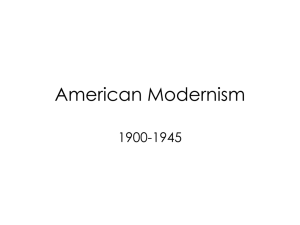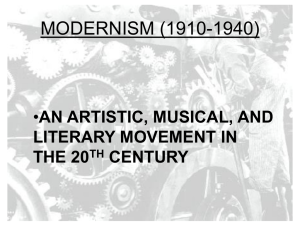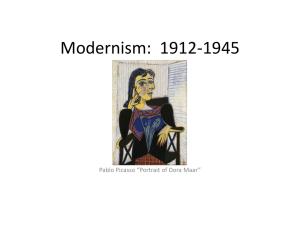American Architecture, 1975–2000
advertisement
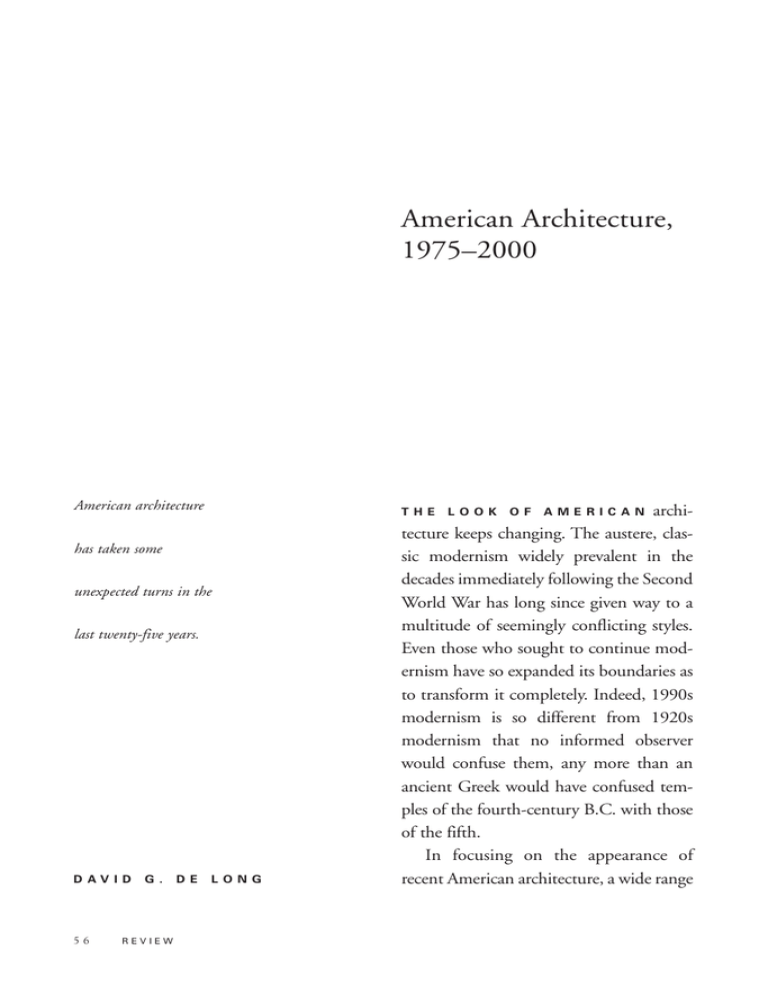
American Architecture, 1975–2000 American architecture has taken some unexpected turns in the last twenty-five years. DAVID 56 G. REVIEW DE LONG T H E L O O K O F A M E R I C A N architecture keeps changing. The austere, classic modernism widely prevalent in the decades immediately following the Second World War has long since given way to a multitude of seemingly conflicting styles. Even those who sought to continue modernism have so expanded its boundaries as to transform it completely. Indeed, 1990s modernism is so different from 1920s modernism that no informed observer would confuse them, any more than an ancient Greek would have confused temples of the fourth-century B.C. with those of the fifth. In focusing on the appearance of recent American architecture, a wide range of influences can be discerned that can be grouped into two broad categories: far sources and near sources. Far sources are those that are either distant in time, or remote in terms of modern expectations. They reflect pre-modern, or historicizing, images on the one hand, and popular, or commercial, images on the other. Historicizing images include motifs drawn from the entire history of architecture as well as from twentieth-century decorative styles such as Art Deco, all of which were firmly rejected by orthodox modernist architects. Popular images include motifs drawn from ordinary buildings and objects, and from commercial and vernacular sources. Parallel with the Pop art of the 1960s, these images are not transformed through sophisticated modification, but openly celebrated for what they are. Buildings incorporating far sources, often referred to as postmodern, deal with figural or representational imagery, with symbolism, and with the reestablishment of architecture as a communicative art in the traditional sense. The second category of influences derive from modern vocabularies of the twentieth century, and thus are “near” in time. Near sources are essentially abstract. At one extreme, the buildings in this category suggest a renewed awareness of early twentieth-century expressionism, especially in art movements such as German Expressionism, Italian Futurism, and Russian Constructivism. They are characterized by non-Euclidian geometries, by exaggerated textures, and by sculptural forms. At the other extreme of near sources are those derived from orthodox modernism, signaled in part by simple geometries and clearly defined volumetric enclosures. Buildings incorporating near sources communicate through their forms rather than through secondary elements applied to those forms. Extremes of near sources, like those of far sources, can be found in a single building, blurring rigid boundaries. Yet the extremes, like bookends, offer a useful way of looking at current architectural trends. In this article, examples grouped under “Inventing Tradition” are at one end of the “far” spectrum, while those under “Celebrating the Everyday” are at the other; the examples grouped under “Redefining Expressionism” are at one end of the “near” spectrum, and those under “Expanding Modernism” are at the other. INVENTING TRADITION Nowhere has tradition been more pervasively invented than in planned communities designed to evoke images of another time. A famous example is the vacation enclave of Seaside, Florida, which began in the early 1980s. It has been described by the New York Times as “the recreation of a REVIEW 57 small-town America that in truth never existed.” It provided the perfect setting for the satirical motion picture, The Truman Show, in which the town itself was portrayed as an elaborate stage set of imagined perfection. The revival of traditional planning values that Seaside illustrates with its cozy densities, low-scaled ambience, and pedestrian-friendly layout has come to be known as new urbanism. Its most acclaimed proponents are Andrés Duany and Elizabeth Plater-Zyberk, the planners of Seaside. Their incorporation of local building styles at Seaside produced a convincing ensemble that has challenged modern concepts of larger-scaled, more automobile-dependent planning. Later examples of new urbanism include Celebration, the town created by the Disney Company near its theme parks in Orlando, Florida. Celebration was planned by Robert A. M. Stern and Jaquelin Robertson. Its houses are advertised as having six styles: Classical, Victorian, Colonial Revival, Coastal, Mediterranean, and French. Nostalgia clearly figures heavily in new urbanism, and the town of Celebration has been described by one critic as a “revival of Norman Rockwell’s America.” Yet new urbanism has a substantial pedigree: Duany and Plater-Zyberk were both students at Yale, where they were influenced by Vincent Scully; Plater-Zyberk worked 58 ZELL/LURIE REAL ESTATE CENTER in the office of Robert Venturi and Denise Scott Brown; and two books of considerable renown are credited as being fundamental to the new urbanism—Colin Rowe and Fred Koetter’s Collage City and Jane Jacobs’s The Death and Life of Great American Cities. Buildings with the look of another time, such as those in Seaside or Celebration, illustrate an aspect of what has come to be called postmodernism: a historicizing mode that expresses one part of our postmodern era. Critics generally identify Robert Venturi and Denise Scott Brown as the parents of this movement, as a result of their joint design work and books such as Complexity and Contradiction in Architecture and Learning from Las Vegas. In their Sainsbury Wing of the National Gallery in London, which opened in 1991, Venturi and Scott Brown show how very challenging and of its time postmodernism can be. Attached to the main nineteenth-century building by William Wilkins, the front façade incorporates classical elements such as columns and window frames, establishing a sympathetic relationship. But as the distance between the new façade and the older building increases, these elements gradually flatten out and become more widely spaced, which subtly reveals them as modern representations. The façade itself lacks the customary monumental scale and formality of classicism, but instead steps back asymmetrically, a deferential gesture toward the part of Trafalgar Square that it overlooks. Unframed openings cut into the façade lead to a quiet, unassuming entrance. Inside, on the upper floor, the Sainsbury galleries acknowledge the main building’s formally linked rooms, but the new axes of the Wing are angled in ways that animate conventional regularity, and the enclosed areas along these new axes are framed by a robust, inventive Tuscan order that works yet another transformation of traditional imagery. In these and other ways, Venturi and Scott Brown respond to, but never replicate, the eclectic classicism of the nineteenth century. The result is an invented tradition of a very high order indeed. Other architects working with historical precedents have invented styles that are more specific than allusive, but with such variety as to express their own time. Michael Graves illustrates this approach in a seductive 1980s design for the Clos Pegase Winery in California’s Napa Valley. The diversity of forms, and their responsive enhancements of the local landscape, recall the spirit and even the image of ancient Roman villas, and an actual villa (the client’s house) sits regally atop a hill, overlooking the adjoining winery. Other Roman allusions include a circular rotunda (as yet unbuilt) that recalls the ancient Mausoleum of Augustus in Rome. The steep terraces enclose a circular nymphaeum, its water drawn by an axial channel from a source on the hill above. It is meant to recall the place in Greek mythology where the imprint of Pegasus’s hoof caused the spring of the Muses to flow. The muscular classicism of the winery suggests both a rustic Roman villa and the late eighteenth-century designs of Claude-Nicolas Ledoux. Modernism is far from obvious in this romantic complex, which, in its Napa Valley setting, seems to embody those relaxed pleasures associated with its product since the beginning of history. CELEBRATING THE E V E R Y D AY Within the town of Seaside, new buildings reflecting a local vernacular abound. Together with buildings recalling traditional styles of a more elevated sort, these structures also help evoke some golden age of uncertain origin, an age remote from the more immediate reality of our own time. Elements such as folksy porches, simple gables, and low turrets indigenous to older buildings in the area are not reworked, refined, or disguised, but embraced for their very obviousness. Again, the sense of friendly communication seems part of the objective, and the result has obvious, accessible charm. REVIEW 59 For Venturi and Scott Brown, making art out of the ordinary has long been a way of celebrating the everyday. In the Mielmonte Nikko Kirifuri hotel and spa in Japan, completed in 1997, they are inspired by the anonymous buildings of local villages as well as the vitality of villagescaled Tokyo shopping streets. Copying the look of ordinary Japanese houses, they fixed rafters to the otherwise simply profiled wings of the hotel. The rafters themselves are not structural but decorative. They look like stage props decorating an otherwise modern structure, recalling but not imitating vernacular building. Similarly representational is the hotel lobby, which suggests a typical street of small Japanese shops, embellished with cartoon-like, two-dimensional images of streetlights, public telephones, and hanging baskets. These images line the sides of the lobby and contribute to a visual impression of agreeable density. Stanley Tigerman and Margaret McCurry of Chicago also celebrate the everyday in their work, as in the Power House Energy Education Center in Zion, Illinois. The stepped profile and crisp detailing derive from the simple lines of ordinary industrial buildings, or, more particularly, of barns. Fire stairs placed at regular intervals along the structure project out at an angle of thirteen degrees to its main axis, positioned 60 ZELL/LURIE REAL ESTATE CENTER so they parallel nearby structures and help unify the building with its setting. These projecting elements, together with angled exhibition enclosures inside, provide a degree of sophistication that distances the 336-foot-long building from nostalgic romanticism. REDEFINING EXPRESSIONISM During the last quarter of the twentieth century, a revived expressionism rose to a position of stylistic prominence in America. No building more fully embodies this trend than Frank Gehry’s Guggenheim Museum in Bilbao, Spain. Completed in 1997 and clad in titanium, the whole appears seamless and devoid of scale, and it offers striking parallels with examples of German expressionism from the late 1910s and early 1920s. These earlier projects were unbuildable fantasies, conceived to illustrate utopian ideals; Gehry’s buildings are not only buildable, but immensely popular. Expressionism has been an ongoing, if sometimes overlooked, current of modern architecture. The German architect Eric Mendelsohn built the Einstein Tower in Potsdam in 1919-21. Beginning in the 1920s, Frank Lloyd Wright infused his early designs with expressionistic forms such as the exotic spiral of the Gordon Strong Automobile Objective unbuilt in Maryland. Later examples of modern expressionism include Le Corbusier’s Chapel at Ronchamp and Eero Saarinen’s TWA Terminal at Idlewild (now John F. Kennedy) Airport. Today’s architects have redefined the expressionism of the early twentieth century in various ways, not least by making it buildable. Their buildings also deal more readily with actual needs and accommodate real functions. More important, responded to context and have established persuasive coherence in urban settings, as Gehry did at Bilbao by joining his building to adjacent streets and even bridges in ways that infused the city with renewed energy. The Guggenheim’s complex geometries were thus part of a larger whole. In some cases, this context relates to the reworking of a preexisting building, notably the Jewish Museum of San Francisco (scheduled for completion in 2002) by Daniel Libeskind. In this instance, Bruce Goff’s first, unbuilt design for the Price Studio in Bartlesville, Oklahoma in the early 1950s provides an obvious antecedent. Libeskind may have been aware of Goff’s design, as it had been published on several occasions, but more probably the resemblance is coincidental, or at least subliminal. Through deeply theoretical explanations accompanied by intense spatial analysis of existing sites, Peter Eisenman gives special resonance to the complicated forms of his work. In the Aronoff Center for Design and Art at the University of Cincinnati, he reconfigured three existing buildings into a unified structure through an addition that transformed these relatively anonymous structures into something of singular importance. The plan derives from abstractions of chevron-like shapes—his interpretation of the essential qualities in those preexisting forms. The twisting volume that results allows each major space to be individually shaped, a characteristic evident in the differently angled elements of the elevations. Generated between the new and old structures is a grand, street-like space appropriately energetic for the shared activities it contains. Nearer the edge of redefined expressionism are architects whose theories depart decisively from those discussed above, but who explore similar vocabularies. For example, Bart Prince—a former employee of Bruce Goff—remains committed to the structural determinism of his mentor, conceiving his buildings as part of a comprehensive program that relates to specific conditions of material, assembly, and site. Prince tailors each building to his client’s needs as he interprets them, often incorporating richly decorative elements (such as lighting, furniture, and fountains) of his own invention. In recent years, his work has become more abstract, as seen in a 1990s house REVIEW 61 near Mendocino, California. From the exterior, the structural frame of twisted supports is partly revealed through irregular openings in the curving, shingled enclosure. In seeming contrast to its complicated shapes, the plan, although far from simple, is generated by recognizable Euclidian shapes such as circles. In this, Prince reaffirms his ties to the work of both Goff and Wright. Together with those architects, he helps sustain American expressionism. EXPANDING MODERNISM Modernism has remained an ongoing tradition, but since the 1970s that tradition has been expanded. It now includes a wider range of materials and shapes, richer textures, and more complex geometric variations. Some examples of expanded modernism remain oriented toward structural expression and a clear definition of interior space, but typically with less emphasis on those elements than in earlier decades. The decorative qualities of an earlier modernism are frequently manipulated, often by exaggerating the scale of selected elements, so that everything seems bigger, and often is. The J. Paul Getty Center in Los Angeles by Richard Meier is the most prominent icon of this expanded modernism. No other twentieth-century arts 62 ZELL/LURIE REAL ESTATE CENTER complex can surpass the Getty for sheer size and cost (completed in 1997, the project took more than a decade). Although the buildings are tenuously linked by thin passages, they seem almost as clearly detached from each other as those of earlier modernist composition such as Mies van der Rohe’s campus for the Illinois Institute of Technology in Chicago. The individual shapes of the separated buildings are more varied than those of the earlier prototype; the scale of the outdoor spaces is far grander; and the whole is more richly embellished with elegant materials and sumptuous components. But the spirit of modernism prevails. The Barclay Simpson Sculpture Studio at the California College of Arts and Crafts in Oakland, by San Francisco architect Jim Jennings, is an example of what the New York Times critic Herbert Muschamp has called “baseline Modern,” a less bombastic version of expanded modernism. A rough concrete base and strongly textured glass-block walls recall both Mies van der Rohe and the early French modernist Pierre Chareau. Other Jennings designs bring to mind the later work of Louis I. Kahn. In this regard, Jennings’s recent work parallels that of the Japanese architect Tadao Ando. Somewhat closer to orthodox modernism are the Yerba Buena Lofts in San Francisco by Stanley Saitowitz. Designed as artists’ housing, they recall in their function those numerous and far larger complexes for workers and artisans that formed a social underpinning of European modernism in the 1920s. Saitowitz works elegant variations on those earlier prototypes. Setbacks soften the slab-like form, relieving the regularity of the gridded structure, and a seemingly random pattern of glazing provides a welcome sense of spontaneity. Other architects move freely along the continuum joining modernism and expressionism. For example, in their Neurosciences Institute in La Jolla, California, Tod Williams and Billie Tsien combine equal portions of both. Meanwhile, New York architect George Ranalli draws more fully from a modernist vocabulary, and, like Jim Jennings, is partly influenced by Kahn. In many examples by Ranalli, strong textures and complicated patterns of fenestration provide expressive qualities. In the renovated interior of a New York loft, interlocking shapes and wood play against plaster and brick. The work of Steven Holl falls between modernism and expressionism, incorporating aspects of both to achieve an enviable balance. The plan of the Stretto House in Dallas defines regular, orthogonal spaces that are roofed by fragmented vaults of a more complicated geometry. The care with which Holl resolves masonry and roof details to achieve an integrated sense of ornamentation echoes Louis Kahn’s nearby Kimbell Museum. Yet Holl has reworked that prototype, fragmenting both walls and vaults to achieve a decidedly different result. THE FUTURE What is the future direction of American architecture? Philip Johnson, who is without question the dean of American architecture, has usually been the first to sniff out new architectural fashions. In 1932, together with Henry-Russell Hitchcock, he coined the term International Style; in 1984 he built the first postmodernist skyscraper, the AT&T Building in New York; later, his designs reflected expressionist trends. Recently, Johnson has begun to explore the common profiles of ordinary farm buildings, suggesting that the next fashion may well be some form of the “everyday.” Or, will architects take a page from Venturi and Scott Brown’s sketch-book and further examine historical symbols? I would argue that it is “near” rather than “far” sources that will provide the broadest potential for meaningful architectural development. Modernist sources are better positioned to expand the traditions of our own time further into the twenty-first century. As the best elements of those seemingly divergent modern sources are reworked and gradually joined, and the REVIEW 63 divisions themselves are revealed as ever more arbitrary, a true and workable fusion of extremes should occur. Instead of seeking to separate today’s architectural currents into their component parts, we should no doubt welcome the creative forces that are drawing them closer together. This article is adapted from a catalog essay accompanying the exhibition “US Design 1975–2000,” which was shown at the Denver Art Museum in February–May 2002, and will travel to Miami, New York, and Memphis. 64 ZELL/LURIE REAL ESTATE CENTER

